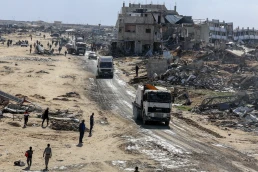Unexploded Ordnance and the Weaponry We Leave Behind
By Andrea Mazzarino, Tom Dispatch
Count on one thing: armed conflict lasts for decades after battles end and its effects ripple thousands of miles beyond actual battlefields. This has been true of America’s post-9/11 forever wars that, in some minimalist fashion, continue in all too many countries around the world. Yet those wars, which we ignited in Afghanistan, Iraq, and Pakistan in the wake of the 9/11 attacks, are hardly the first to offer such lessons. Prior wars left us plenty to learn from that could have led this country to respond differently after that September day when terrorists crashed planes into the World Trade Center in New York City and the Pentagon in Washington, D.C. Instead, we ignored history and, as a result, among so many other horrific things, left our weaponry — explosives, small arms, you name it — in war zones to kill and maim yet more people there for generations to come.

Case in point: We Americans tend to disregard the possibility (however modest) that weapons of war could even destroy our own lives here at home, despite how many of us own destructive weaponry. A few years ago, my military spouse and I were looking for a house for our family to settle in after over a decade of moving from military post to military post. We very nearly bought an old farmhouse owned by a combat veteran who mentioned his deployments to Afghanistan and Iraq. We felt uncertain about the structure of his house, so we arranged to return with our children to take another look after he had moved out. The moment we entered the garage with our two toddlers in tow, we noticed a semi-automatic rifle leaning against the wall, its barrel pointing up. Had we not grabbed our son by the hand, he might have run over to touch it and, had it been loaded, the unthinkable might have occurred. Anyone who has raised young children knows that a single item in an empty room, especially one as storied as a gun (in today’s age of constant school shootings and lockdowns) could be a temptation too great to resist.
That incident haunts me still. The combat vet, who thought to remove every item from his home but a rifle, left on display for us, was at best careless, at worst provocative, and definitely weird in the most modern meaning of that word. Given the high rates of gun ownership among today’s veterans, it’s not a coincidence that he had one, nor would it have been unknown for a child (in this case mine) to be wounded or die from an accidental gunshot. Many times more kids here die that way, whether accidentally or all too often purposely, than do our police or military in combat. Boys and men especially tend to be tactile learners. Those of them in our former war zones are also the ones still most likely to fall victim to mines and unexploded ordnance left behind, just as they’re more likely to die here from accidental wounds.
Scenes not that different from the one I described have been happening in nearly 70 countries on a regular basis, only with deadlier endings. Hundreds of people each year — many of them kids — happen upon weapons or explosives left over from wars once fought in their countries and are killed, even though they may have been unaware of the risks they faced just seconds before impact. And for that, you can thank the major warmakers on this planet like the U.S. and Russia that have simply refused to learn the lessons of history.
A Deadly Glossary
Many kinds of explosives linger after battles end. Such unexploded ordnance (UXO) includes shells, grenades, mortars, rockets, air-dropped bombs, and cluster munition bomblets that didn’t explode when first used. Among the most destructive of them are those cluster munitions, which can spread over areas several football fields wide, often explode in mid-air, and are designed to set objects on fire on impact. Militaries (ours among them) have been known to leave behind significant stockpiles of such explosive ordnance when conflicts cease. Weapons experts refer to such abandoned ordnance as AXO and it’s not uncommon for militaries to have stored and then abandoned them in places like occupied schools.
Close cousins of UXO are landmines designed to explode and kill indiscriminately upon contact, piercing tanks and other vehicles, as well as what came to be known as Improvised Explosive Devices (IEDs), jerry-rigged homemade bombs often buried in the ground, that kill on impact. IEDs gained notoriety during the American wars in Afghanistan and Iraq, where they accounted for more than half of reported U.S. troop casualties. And both unexploded landmines and IEDs can do terrible damage years later in peacetime.
As many of us are aware, long before this century’s American-led wars on terror started, militaries had already established just such a deadly legacy through their use of unexploded ordnance and mines. In Cambodia, which the U.S. bombed heavily during the Vietnam War in the 1960s and early 1970s, about 650 square kilometers remain contaminated with cluster-munition remnants from American aerial attacks, while a still larger area contains landmines. It’s estimated, in fact, that leftover landmines and other exploding ordnance killed nearly 20,000 Cambodians in what passed for “peacetime” between 1979 and 2022, also giving that country the dubious distinction of having one of the highest number of amputees per capita on the planet. Likewise, half a century after the U.S. littered neighboring Laos with cluster bombs, making it, per capita, the most bombed country in the world, less than 10% of its affected land has been cleared.
Similarly, dud bomblets, which failed to detonate in mid-air, are estimated to have killed or maimed somewhere between 56,000 and 86,000 civilians globally since Hitler’s air force first tested them out on Spanish towns during that country’s civil war in the 1930s. Despite concerted international advocacy by governments and human rights groups beginning in the 2000s, hundreds of new cluster munition casualties are reported yearly. In 2023, the most recent year on record globally, 93% of cluster munition casualties were civilians, with 47% of those killed and injured by such remnant explosives children.
Cluster munitions are known for killing broadly on impact, so it’s not easy to get firsthand accounts of just what it’s like to witness such an attack, but a few such unflinching accounts are available to us. Take for instance, a report by Human Rights Watch researchers who interviewed survivors of a Russian cluster munitions attack in the eastern Ukrainian village of Hlynske in May 2022. As one man reported, after hearing a rocket strike near his home, “Suddenly I heard my father screaming, ‘I’ve been hit! I can’t move,’ he said. I ran back and saw that he had fallen on his knees but couldn’t move from the waist down, and there were many metal pieces in him, including one sticking out of his spine and another in his chest. He had these small metal pellets lodged in his hands and legs.”
According to the report, his father died a month later, despite surgery.
How did a noise outside that survivor’s home so quickly become shrapnel lodged in his father’s body? Maybe someone growing up in America’s poorer neighborhoods, littered with weapons of war, can relate, but I read accounts like his and realize how distant people like me normally remain from war’s violence.
After the international Cluster Munitions Convention took effect in 2010, 124 countries committed to retiring their stockpiles. But neither the U.S., Russia, nor Ukraine, among other countries, signed that document, although our government did promise to try to replace the Pentagon’s cluster munitions with variants that supposedly have lower “dud” rates. (The U.S. military has not explained how they determined that was so.)
Recent Posts
‘People in Venezuela Can Oppose the Government But Still Reject US Intervention’:
January 18, 2026
Take Action Now CounterSpin interview with Michelle Ellner on Venezuela invasionBy Janine Jackson, FAIR Janine Jackson interviewed CODEPINK’s…
Social Strikes: Confronting ICE and Resisting Authoritarianism
January 17, 2026
Take Action Now An in-depth discussion with Jeremy Brecher on the strategy, potential, and challenges of mass social strikes following the Minnesota…
Israeli Ban on 37 Aid Organizations Expected to Have Devastating Impacts Across Palestine
January 16, 2026
Take Action Now Aid organizations say Israel’s recent ban of 37 groups has dealt a severe blow to humanitarian work across Palestine. In Gaza, it…
U.S. Surging Military Assets To the Middle East To Prepare for War With Iran After Trump Postpones Attack
January 16, 2026
Take Action Now Reports claim that Netanyahu asked Trump to delay the attack as Israel wants more time to prepare for counterattacksBy Dave…




